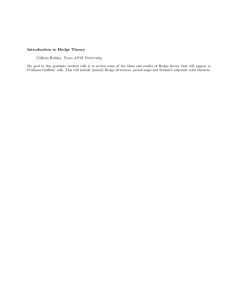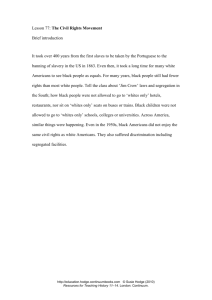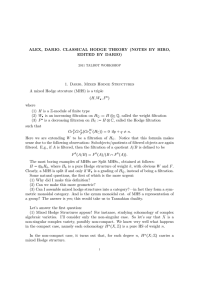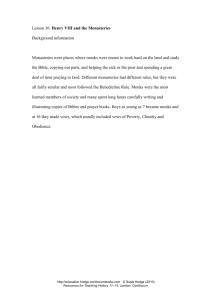Eduardo Cattani, Fouad El Zein, Phillip A. Griffiths, Lˆ e D˜ ung Tr´
advertisement
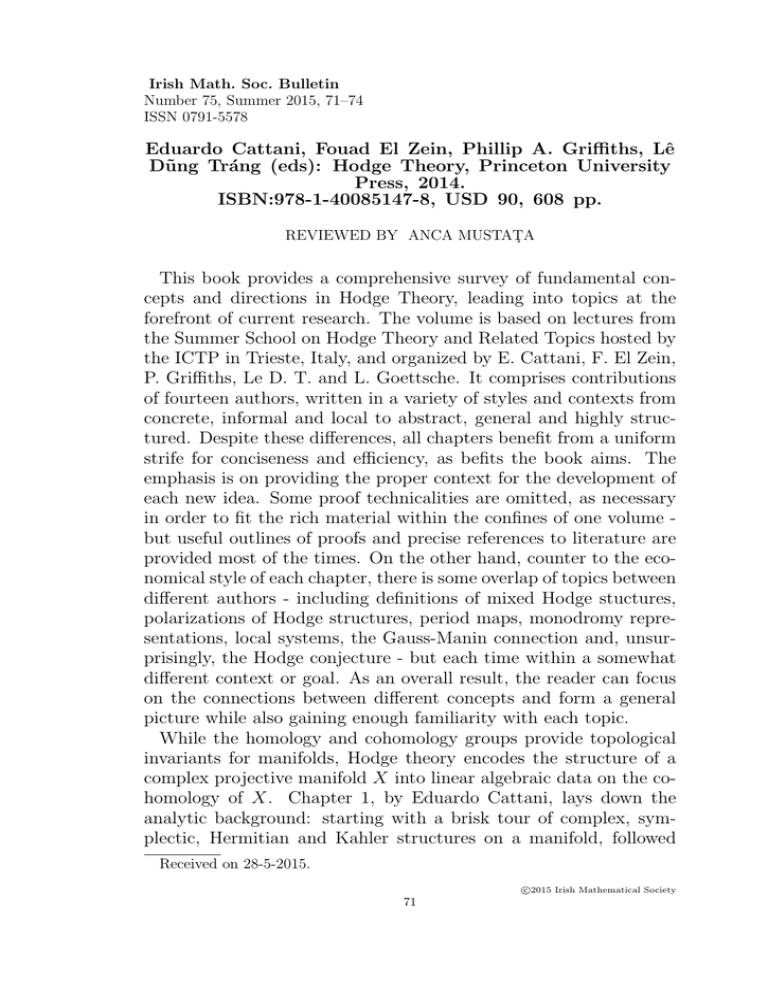
Irish Math. Soc. Bulletin Number 75, Summer 2015, 71–74 ISSN 0791-5578 Eduardo Cattani, Fouad El Zein, Phillip A. Griffiths, Lê Dũng Tráng (eds): Hodge Theory, Princeton University Press, 2014. ISBN:978-1-40085147-8, USD 90, 608 pp. REVIEWED BY ANCA MUSTAŢA This book provides a comprehensive survey of fundamental concepts and directions in Hodge Theory, leading into topics at the forefront of current research. The volume is based on lectures from the Summer School on Hodge Theory and Related Topics hosted by the ICTP in Trieste, Italy, and organized by E. Cattani, F. El Zein, P. Griffiths, Le D. T. and L. Goettsche. It comprises contributions of fourteen authors, written in a variety of styles and contexts from concrete, informal and local to abstract, general and highly structured. Despite these differences, all chapters benefit from a uniform strife for conciseness and efficiency, as befits the book aims. The emphasis is on providing the proper context for the development of each new idea. Some proof technicalities are omitted, as necessary in order to fit the rich material within the confines of one volume but useful outlines of proofs and precise references to literature are provided most of the times. On the other hand, counter to the economical style of each chapter, there is some overlap of topics between different authors - including definitions of mixed Hodge stuctures, polarizations of Hodge structures, period maps, monodromy representations, local systems, the Gauss-Manin connection and, unsurprisingly, the Hodge conjecture - but each time within a somewhat different context or goal. As an overall result, the reader can focus on the connections between different concepts and form a general picture while also gaining enough familiarity with each topic. While the homology and cohomology groups provide topological invariants for manifolds, Hodge theory encodes the structure of a complex projective manifold X into linear algebraic data on the cohomology of X. Chapter 1, by Eduardo Cattani, lays down the analytic background: starting with a brisk tour of complex, symplectic, Hermitian and Kahler structures on a manifold, followed Received on 28-5-2015. c 2015 Irish Mathematical Society 71 72 ANCA MUSTAŢA by constructions of the de Rham and Dolbeaut complexes of differential forms leading to the definition of de Rham and Dolbeaut cohomologies. The Hodge decomposition of the cohomology groups is introduced via harmonic forms. No proof is given, but the preliminary work is concrete and detailed enough, without over-reliance on long computations: these are relegated to exercises. The author pays due attention to the Kahler metric on a projective manifold, and the relation between the Kahler form and the hyperplane class. This induces an extra structure on the cohomology groups called polarization, or equivalently a Hermitian metric whose orthogonal decomposition is compatible with the Hodge decomposition, and leads to a further splitting of the Hodge groups (the Lefschetz decomposition). While Chapter 1 starts with the definition of a holomorphic map, this inclusive beginning is rather deceptive. The following chapters will assume a background in algebraic geometry and homological algebra. Chapter 2 contains a new proof of Grothendieck’s Algebraic de Rham Theorem, whereby the cohomology of an algebraic manifold (not necessarily compact) can be calculated based on sheaves of algebraic differential forms. Spectral sequences provide a unitary and elegant framework for the discussion in Chapters 2 and 3, by Fouad el Zein with co-authors Loring W. Tu and Lê Dũng Tráng: starting from sheaf cohomology, and continuing with mixed Hodge complexes and structures. Surprisingly though, spectral sequences are only defined on page 134, some 40 pages after their first use in Chapter 2, and are only truly fleshed out 20 pages later. The important concept of mixed Hodge structures (MHS) first occurs in a highly formal, abstract presentation, but the patient reader is fully rewarded by a nice geometric motivation at the end of Chapter 3: Given a non-compact quasi-projective variety X, we can embedd it in a projective manifold Y such that the complement D admits a nice structure, called a normal crossing divisor (NCD). Then the holomorphic differential forms on X can be related to differential forms on Y with poles along D, via so called residue maps. Thus the simplicial structure given by the components of D leads to a new filtration on the cohomology of X, the weight filtration. Together with the Hodge filtration, this forms a MHS, which will occur often in the rest of the book. BOOK REVIEW 73 Chapter 4 by James Carlson is refreshingly concrete and serves as an analytical preamble for the presentation of Variations of Hodge Structures (VHS) by Eduardo Cattani in Chapter 7. A fixed topological space X can have many different complex structures. This leads to the construction of a classifying space of Hodge structures (with fixed polarization and Hodge numbers). Any family of complex structures (Xb )b∈B yields a map from the basis B to this moduli space, the period map, whose differential yields the Gauss-Manin connection. In the case when B is not compact, the remarcable properties of the Gauss-Manin connections lead to an extension of Hodge structures at the limit. Cattani presents the asymptotic behaviour of the period map, helpfully illustrating it by the concrete example of the mirror quintic. Chapters 5, 6, and 8 by Luca Migliorini, Mark Andrea de Cataldo, Patrick Brosnan and Fouad El Zein respectively, all deal with variations of mixed Hodge structures (VMHS): for algebraic families of (possibly singular) varieties, they discuss the interplay of the corresponding MHS-s. Thinking of the members of such a family as fibres of an algebraic morphism, not necessarily smooth nor proper, they organize the study of the MHS-s in terms of a suitable stratification of the target. This leads to a decomposition theorem, which shows how the intersection cohomology groups of the domain split into a direct sum of intersection cohomology groups on the target. Again, this requires an intricate formalism, involving e.g. the category of perverse sheaves, and most arguments are only sketched in these chapters. The focus is on illustrating the theorem through a series of well chosen examples - de Cataldo’s chapter is just a long sequence of exercises. One cannot help but feel that this chapter was written in some haste and the onus is left on the reader to slowly flesh it out - while references provided are sometimes imprecise. Patrick Brosnan and Fouad El Zein follow the evolution of the geometric ideas, focusing on the case when the fibres of the family are not compact, and building on from their discussion of the NCD case in Chapter 3. Linking in with the chapters on classifying spaces, they finish with recent results on admissible normal function (describing an admissible variation of graded-polarized mixed Hodge structures), and their algebraic zero-locus. Chapter 9 by Jacob Murre is a beautiful survey on the various equivalence relations on algebraic cycles, the relations between them 74 ANCA MUSTAŢA and between their respective quotient groups. The cycle map, AbelJacobi map and Albanese map provide links with Hodge structures. The exact nature of these connections has been long investigated, making the subject of the celebrated Hodge and Bloch-Beilison conjectures. Mark Green’s Chapter 10 transposes the main themes of Hodge theory to the case of varieties generated over number fields, resulting in many conjectures. Recent results by Mark Green and Phillip Griffiths are illustrated by examples in the last sections. Chapters 10 and 11 are due to a new generation of mathematicians who have already made important contributions to Hodge theory: Francois Charles, Christian Schnell and Matt Kerr. In these chapters they discuss arithmetic aspects of Hodge theory in well-thought out and largely self-contained presentations. While the present volume cannot replace classics like [1], [2], [3], [4], [5], it can serve as a good reference, or road-map, for readers interested in Hodge theory. It outlines the development stages of main themes, and their interactions, and it can point the reader towards new exciting directions. References [1] Phillip Griffiths and Joseph Harris. Principles of algebraic geometry. Wiley Classics Library. John Wiley & Sons Inc., New York, 1994. Reprint of the 1978 original. [2] J. Carlson, S. Muller-Stach, C. Peters, Period mappings and Period Domains, Cambridge Studies in Advanced Mathematics 85, 2003. [3] Claire Voisin. Hodge theory and complex algebraic geometry. I, volume 76 of Cambridge Studies in Advanced Mathematics. Cambridge University Press, Cambridge, English edition, 2007. Translated from the French by Leila Schneps. [4] Claire Voisin. Hodge theory and complex algebraic geometry. II, volume 77 of Cambridge Studies in Advanced Mathematics. Cambridge University Press, Cambridge, english edition, 2007. Translated from the French by Leila Schneps. [5] Jose Bertin, Jean-Pierre Demailly, Luc Illusie, and Chris Peters. Introduction to Hodge theory, volume 8 of SMF/AMS Texts and Monographs. American Mathematical Society, Providence, RI, 2002. Translated from the 1996 French original by James Lewis and Peters. Anca Mustaţa is lecturer in mathematics at University College Cork since 2007. Her main research interests lie in the areas of algebraic and complex geometry. School of Mathematical Sciences, University College Cork E-mail address: a.mustata@ucc.ie
